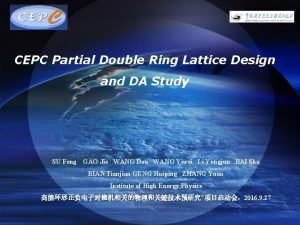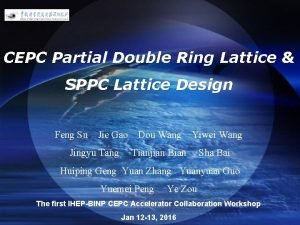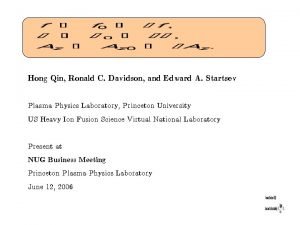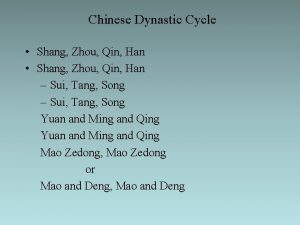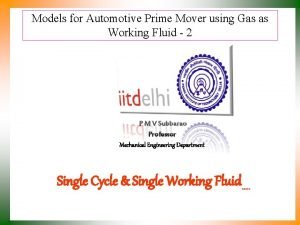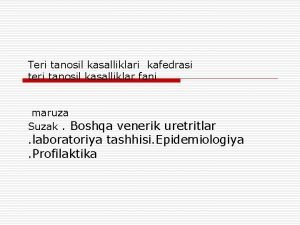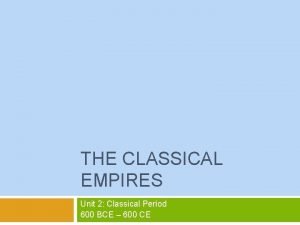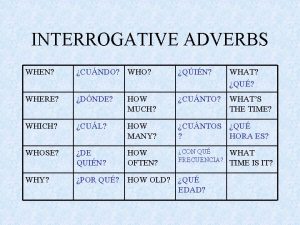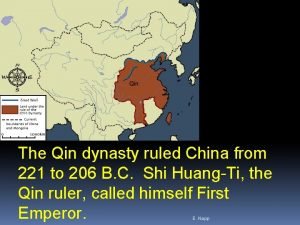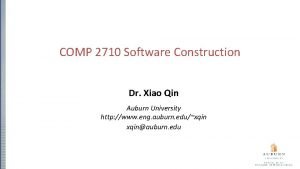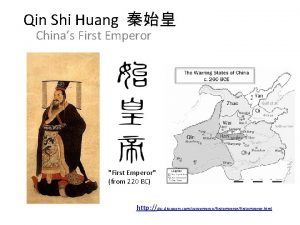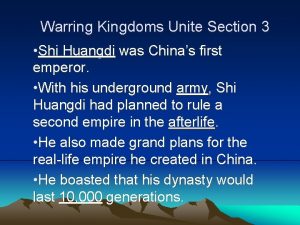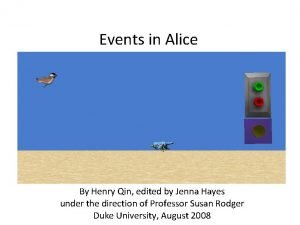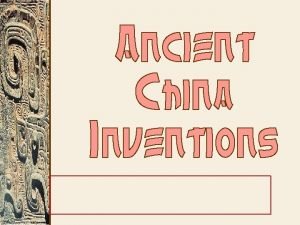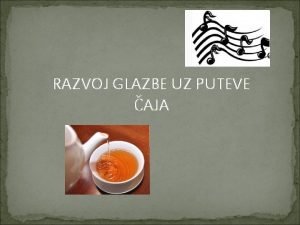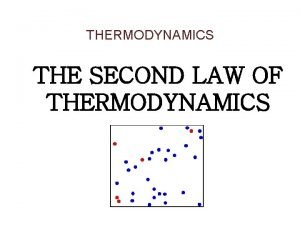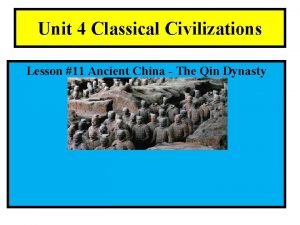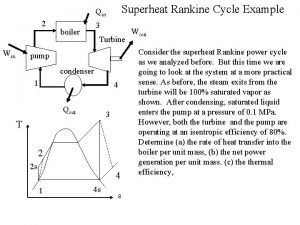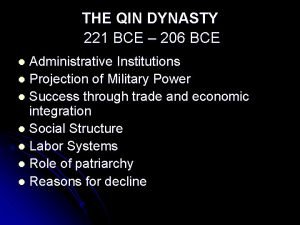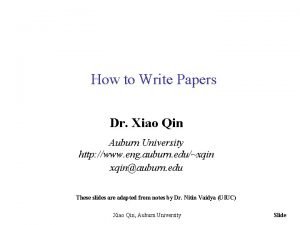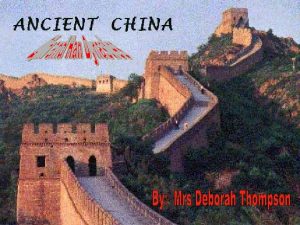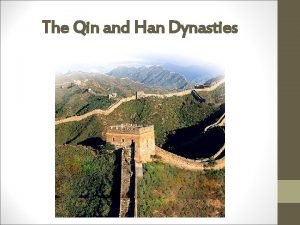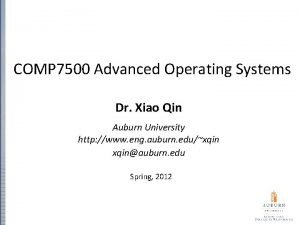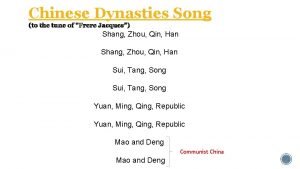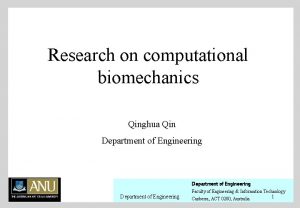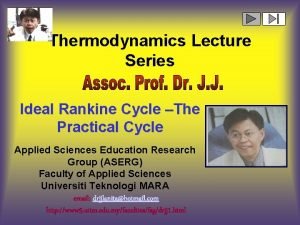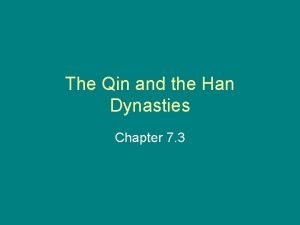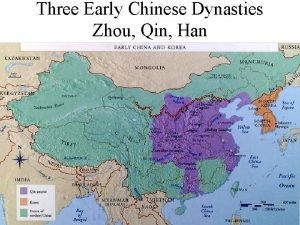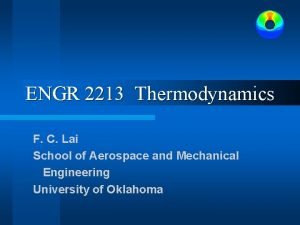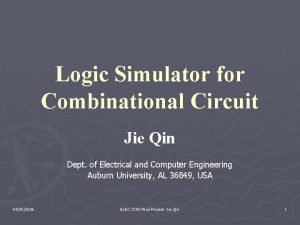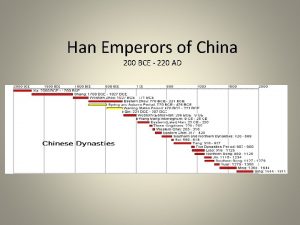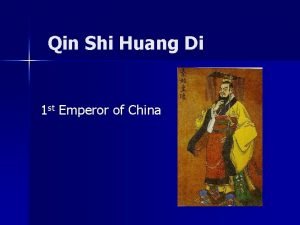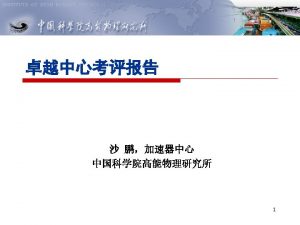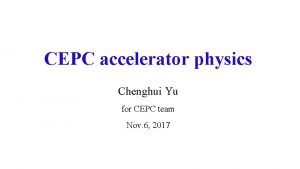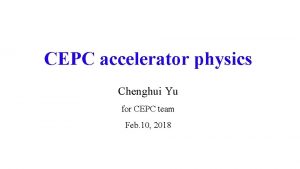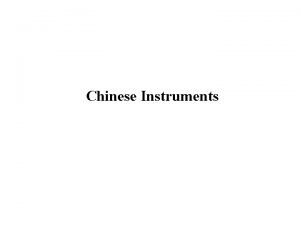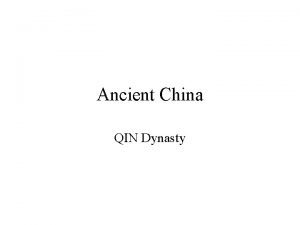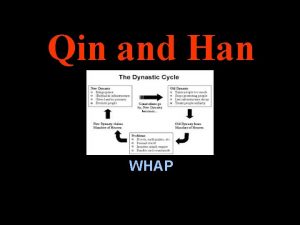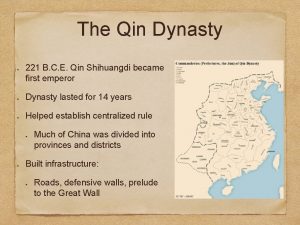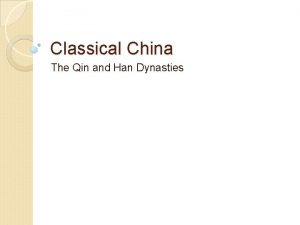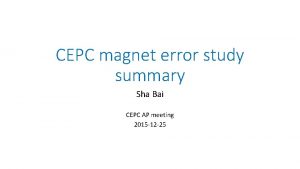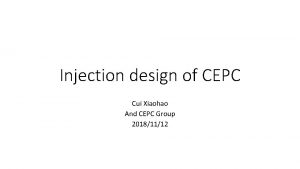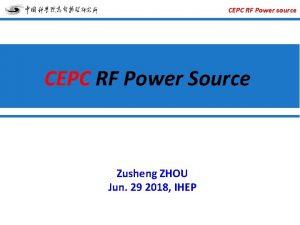CEPC Accelerator Q Qin for the accelerator team









![CEPC main parameter Parameter Unit Value Beam energy [E] Ge. V 120 Circumference [C] CEPC main parameter Parameter Unit Value Beam energy [E] Ge. V 120 Circumference [C]](https://slidetodoc.com/presentation_image_h/0902a90961c4c5e333eae34a84f99b54/image-10.jpg)













































- Slides: 55

CEPC Accelerator Q. Qin for the accelerator team IHEP August 10, 2015

Outline • • • Introduction Accelerator physics Technical system design From CEPC to Spp. C Conclusion

1. Introduction • Motivations – Higgs Boson was discovered three years ago, with a lower energy than expected – Circular collider seems more mature and promising – More high energy physics hide in a possible pp collider converted by electron machine

What is CEPC+Spp. C ?

Livingston Chart on Luminosity CEPC

Accelerator outline • Schematic layout • Linac + booster as injectors CEPC: • Eb=120 Ge. V e+ e- LTB CEPC (50 km-100 km ) Boostr(50 Km -100 km) Spp. C 50 -1 00 Km) – Limited by beamstrahlung & SR (~125 Ge. V) • Cross-section = 200 fb Alain Blondal et al

• Circumference – Determined by Spp. C beam energy – Assume Ecm = at least 70 Te. V for new physics (p-p) Ecm (Te. V) B (T) C (km) 70 12 ~80 70 20 ~50 • Beam power – 50 MW/beam, synchrotron radiation (50+ MW w/FFS) • Luminosity – ≥ 1× 1034 cm-2 s-1/IP

General info of CEPC Ø CEPC is a Circular Electron Positron Collider to study the Higgs boson ½ RF Ø Critical parameters: • • Beam energy: 120 Ge. V Circumference: ~54 km SR power: 51. 7 MW/beam 8*arcs 2*IPs RF 8 RF cavity sections Filling factor of the ring: ~70% IP 1 P. RF S. RF D = 17. 3 km IP 4 IP 2 Ø Length of the straight sections are compatible C = 54. 374 km with Spp. C requirement IP 3 PRF ½ RF RF

Tunnel Cross Section – SPPC + CEPC Magnets Drill/Blast Method 6 m
![CEPC main parameter Parameter Unit Value Beam energy E Ge V 120 Circumference C CEPC main parameter Parameter Unit Value Beam energy [E] Ge. V 120 Circumference [C]](https://slidetodoc.com/presentation_image_h/0902a90961c4c5e333eae34a84f99b54/image-10.jpg)
CEPC main parameter Parameter Unit Value Beam energy [E] Ge. V 120 Circumference [C] m 54752 Number of IP[NIP] 2 SR loss/turn [U 0] Ge. V 3. 11 Bunch number/beam[n. B] 50 Bunch population [Ne] 3. 79 E+11 SR power/beam [P] MW 51. 7 Beam current [I] m. A 16. 6 Bending radius [ρ] m 6094 momentum compaction factor [αp] 3. 36 E-05 Revolution period [T 0] s 1. 83 E-04 Revolution frequency [f 0] Hz 5475. 46 Emittance (x/y) nm 6. 12/0. 018 βIP(x/y) mm 800/1. 2 Transverse size (x/y) mm 69. 97/0. 15 ξx, y/IP 0. 118/0. 083 Beam length SR [σs. SR] mm 2. 14 Beam length total [σs. tot] mm 2. 65 Lifetime due to Beamstrahlung (simulation) min 47 lifetime due to radiative Bhabha scattering [τL] min 52 RF voltage [Vrf] GV 6. 87 RF frequency [frf] MHz 650 Harmonic number [h] 118800 Synchrotron oscillation tune [νs] 0. 18 Energy acceptance RF [h] % 5. 99 Damping partition number [Je] 2 Energy spread SR [σδ. SR] % 0. 132 Energy spread BS [σδ, . BS] % 0. 119 Energy spread total [σδ, tot] % 0. 163 nγ 0. 23 Transverse damping time [nx] turns 78 Longitudinal damping time [n e] turns 39 Hourglass factor Fh 0. 658 Luminosity /IP[L] cm-2 s-1 2. 04 E+34

Accelerator physics Lattice of arc sections Ø Length of FODO cell: 47. 2 m Ø Phase advance of FODO cells: 60/60 degrees Ø Dispersion suppressor on each side of every arc Ø Length: 94. 4 m

Lattice of straight sections Ø Short straight: 18 FODO cells Ø Long straight: 24 FODO cells Ø Length: 849. 6 m Ø Length: 1132. 8 m

Working point Ø The working points are chosen as 193. 08/193. 22 in horizontal and vertical Ø Optimization is done with beam-beam simulations, to have a high luminosity

Beam beam simulations Detailed Luminonisty/Beam Sizes evaluation were performed (Courtesy K. Ohmi, D. Shatilov and Y. Zhang)

Chromatic correction Ø Two families of sextupoles: one family for horizontal, one family for vertical plane Ø One sextupole next to each quadrupole in the arc section Ø The W function for the ring is only a few Ø The chromaticity in both planes has been corrected to a positive value

Dynamic aperture Ø 240 turns is tracked for dynamic aperture Ø Full coupling is assumed for vertical plane Ø The dynamic aperture is: ~ 60σx/60σy or 40 mm/16 mm in x and y for ± 2% momentum spread

Pretzel scheme Ø Horizontal separation is adopted to avoid big coupling Ø No orbit in RF section to avoid beam instability and HOM in the cavity Ø One pair of electrostatic separators for each arc

Effects of pretzel orbit Ø Pretzel orbit has effects on: • Beta functions, tune • Dispersion function, emittance • Chromaticity, dynamic aperture Sextupoles on w/o pretzel orbit w/ pretzel orbit

Sawtooth orbit Ø The energy sawtooth phenomenon has been raised and studied by K. Oide in HF 2012 Ø The total synchrotron radiation energy loss in CEPC ring is 3 Ge. V Ø The beam will have 0. 3% energy difference between the entrance and exit of each arc Ø The maximum orbit distortion is ~0. 6 mm ½ RF IP 1 P. RF S. RF D = 17. 3 km RF IP 4 IP 2 C = 54. 374 km IP 3 RF ½ RF RF

Final Focus System beta. X*=0. 8 m beta. Y*=0. 0012 m L*=2. 5 m DX=DPX=0 αx=αy=0 betax=84 m beta. Y=28 m On momentum Total length: 170 m Off momentum: ± 2%, ± 1% DA optimization w/o pretzel orbit is still under way.

Update of CEPC FFS (FFS_3. 0 mm_v 2_Jul_2015_tmp) • Add additional sextupoles • Vertical tune was corrected to be very flat within the energy acceptance (± 2%) • DA with whole ring need to be checked FT CCS MT Natural chromaticity (incl. FODO) Primary nonlinear corerction High order correction 2 quads βy*=3. 0 mm L*=1. 5 m d=0. 5 m R=16 mm Btip=4. 7 T Ltot=264 m βymax=1200 m ΔU/U=3. 3% Δβ/β=-2. 5% 2 quads ξx=-28. 6/4 ξy=-306. 3/4 reduce ξ contribution from CCS, 1 st order ξ, 2 nd order geo. aberr. High order ξ (tune phase+additi onal sext. ), 3 rd order geo. aberr. from finite length sext. Dynamic aperture with FFS only Dynamic aperture with whole ring To be done TBD an ARC with optimised d. Q/d. J

Bypass design • A bypass is needed to avoid the proton detectors at IP 2 and IP 4. • Take out twelve FODOs from the section "ARC" and put them into bypass. • In the bypass, we use the same magnets (including bends, quadrupole, sextupole) with the main ring. • The deviation is 43. 78 m. • The red line represent the bypass we have designed and the black one represents the version without bypass.

Impedance budget • Resistive wall impedance is calculated with analytical formulas • Impedance of the RF cavities is calculated with ABCI Object Resistive wall (Al) RF cavities (N=378) Total Contributions R [kΩ] L [n. H] kloss [V/p. C] |Z///n|eff [Ω] 16. 8 214. 4 552. 1 0. 0075 40. 1 -- 1313. 6 --- 56. 9 214. 4 1865. 7 0. 0075

Multi-bunch effects • Transverse resistive wall instability with wpn = 2 pfrev × (pnb + nx, y) Ø The growth rate for the most dangerous instability mode is 36 s-1 (τ = 28 ms) in the vertical plane with mode number of μ = 21. ØThe growth time is higher than the transverse radiation damping time. ØThe resistive wall instability is not supposed to happen in the main ring! Growth rate vs. mode number in the vertical plane

Beam ion instability • Ion trapping – With uniform filling pattern, the ions with a relative molecular mass larger than Ax, y will be trapped. – The ions will not be trapped by the beam. • Fast beam ion instability – With uniform filling, the growth time considering ion oscillation frequency spread is 11 ms, which is lower than the damping time. – Fast beam ion instability could occur with uniform filling.

Beam lifetimes caused by different sources in CEPC p Radiation Bhabha lifetime ü Simulated by BBBREM p Beam-gas lifetime p Touschek lifetime Courtesy of N. Wang

3. Technical system design • All technical systems are touched. – Magnet, power supply, vacuum, beam instrumentation, control, mechanics & survey, radiation shielding, RF, power source, cryogenics, injection, etc. • Preliminary design for all technical system is under way. • Superconducting RF, power source are two key and important systems (expensive & power-consuming). • Efforts from IHEP are given to these key systems.

Power source design Collider ring Booster ring Source options @1. 3 GHz/20 k. W level The RF power delivered by the klystron will be fed into the cavity via a WR 1500 waveguide as well as a circulator. Courtesy Z. Zhou 1) Klystrons become costly per W at low power and lowest cost verisons only ~ 40 % efficient; 2) IOTs have higher efficiency (~ 60 %) but higher cost; 3) Solid State Amplifiers (SSAs) cost competitive but currently have low efficiency (35%) - however, high availability (modular), and cost likely to decrease and efficiency increase (expect > 40 % soon). So Booster source option is Solid State Amplifier (SSA)

Power source for main ring Device Type No. Klystron 800 k. W CW 192 PSM 90 k. V/18 A 192 Circulator & load 400 k. W CW 384 LLRF Waveguide 192 WR 1500 Klystron Parameter Freq. (MHz) Bandwidth(MHz) Output power (k. W) Beam voltage (k. V) Beam current (A) Efficiency (%) Gain (d. B) Value 650 ± 0. 5 800 90 18 65 40 PSM Parameter High voltage (k. V) Current (A) Voltage stability (%) Efficiency (%) Turn-off time (us) Stored energy (J) Value 90 18 <2 >90 <5 <15 Circulator Parameter Freq. (MHz) Bandwidth(MHz) Foward power (k. W) Value 650 ± 2 400 < 0. 1 > 26 384 Reflection power(k. W) Insert loss(d. B) Isolation(d. B)

Power source for booster Parameters mode Operation frequency Cavity Type Cavity number RF input power (k. W) Value 1300 MHz± 0. 5 MHz 9 -cell 256 20/cavity 25 k. W Solid state amplifier Parameter Value Frequency (MHz) 1300± 5 Power (k. W) Gain (d. B) Efficiency 25 67 50%@25 k. W

Power source for LINAC RF system (35 sets) Parameter Unit Value e- beam energy e+ beam energy Repetition rate e- bunch population e+ bunch population Ge. V Hz 6 6 50 2× 1010 Klystron output power MW 80 Modulator peak power MW 200

80 MW Klystron Parameters Frequency (MHz) Output power (MW) Efficiency (%) Gain (d. B) Pulse length (us) Pulse rate (pps) Beam voltage (k. V) Beam current (A) Drive power (W) Value 2856 80 42 53 4 50 400 488 350 200 MW Modulator Parameters Value Peak output power (MW) 200 Average output power (k. W) 80 PFN charging voltage (k. V) 50 PFN impedance (Ω) 2. 85 Pulse width (us) > 4 μs (flat top) Pulse flatness (%) ± 0. 15 Pulse rate (pps) 50 Pulse transformer turns ratio 1: 17 Up to now -- • The design of overall parameters of klystron is finished. • The design of beam optics of electron gun is finished. • Resonate cavity parameter design and simulation are under way.

Superconducting RF system Collider Booster Modules / section 12 4 Module length (m) 10 12 Cavities / module 4 8 Cavities / section 48 32 Total modules 96 32 Total cavities 384 256 • Collider: 650 MHz cavity • Booster: 1. 3 GHz cavity • Total cavities: 640 • Total modules: 128 Courtesy J. Y. Zhai & Y. Sun • Total RF length: 1. 4 km • Total RF voltage: 12 Ge. V • Beam power: 104. 5 MW • HOM power: 2 MW

Baseline Parameters and Challenges Parameters CEPC-Collider CEPC-Booster LEP 2 Cavity Type 650 MHz 5 -cell Nitrogen-doped Nb 1. 3 GHz 9 -cell Nitrogen-doped Nb 352 MHz 4 -cell Nb/Cu sputtered Vcav / VRF 17. 9 MV / 6. 87 Ge. V 20 MV / 5. 12 Ge. V 12 MV / 3. 46 Ge. V Eacc (MV/m) 15. 5 19. 3 6 ~ 7. 5 Q 0 4 E 10 @ 2 K 2 E 10 @ 2 K 3. 2 E+9 @ 4. 2 K Cryomodule number 96 (4 cav. / module) 32 (8 cav. / module) 72 (4 cav. / module) RF coupler power / cav. (k. W) 280 c. w. 20 125 RF source number 192 (800 k. W / 2 cav. ) 256 (25 k. W / cav. ) 36 (1. 2 MW / 8 cav. ) HOM power / cav. (k. W) 3. 5 0. 005 0. 3 HOM damper coaxial/waveguide@2 K coupler @ 2 K + ferrite @ RT + ceramic @ 80 K coaxial coupler

Preliminary Cavity Design Parameter Unit Main Ring Booster Cavity frequency MHz 650 1300 Number of cells - 5 9 Cavity effective length m 1. 154 1. 038 Cavity iris diameter mm 156 70 Beam tube diameter mm 170 78 Cell-to-cell coupling - 3 % 1. 87 % R/Q Ω 514 1036 Geometry factor Ω 268 270 Epeak/Eacc - 2. 4 2 Bpeak/Eacc m. T/(MV/m) 4. 23 4. 26 V/p. C 1. 8 3. 34 Cavity transverse loss factor* k⊥ V/p. C/m 2. 4 35. 3 Acceptance gradient MV/m 20 23 - 4 E 10 2 E 10 Cavity longitudinal loss factor* k∥ HOM Acceptance Q 0 at acceptance gradient * main ring bunch length 2. 65 mm, booster bunch length 2. 66 mm

HOM and SOM Damping • Need effective damping of the 3. 5 k. W HOM power per cavity with coaxial coupler or waveguide. Design and simulation ongoing. Waveguide HOM coupler Coaxial HOM coupler Monopole modes impedance Dipole modes impedance

Nitrogen-Doping for High Q 0 Cavity • • Collaborate with Pekin University 1. 3 GHz single cell fine grain cavity tested N-doped with vacuum induction furnace Chemical polishing (BCP) , plasma cleaning PKU

Nitrogen-Doping for High Q 0 Cavity • Six 1. 3 GHz (low loss and TESLA shape, fine grain and large grain) and four 650 MHz single cell cavities and three 1. 3 GHz 9 -cell cavities to be studied • IHEP vacuum resistance furnace also to be used for N-doping • New vertical test Dewar with closed loop helium recycle in commissioning 800 mm ID

Power Coupler and Related R&D Main ring 650 MHz 300 k. W c. w. coupler: high power handling capacity, high yield and reliability two windows for vacuum safety and cavity clean assembly small heat load and effective cooling simple structure for cost saving KEKB (380 k. W) / BEPCII (120 k. W) type as baseline China ADS 650 MHz 150 k. W c. w. coupler in R&D Booster 1. 3 GHz 4 k. W (average) coupler: Similar to XFEL / ILC-type (two-window fixed-coupling) developed by IHEP tested to 6 k. W average (800 k. W pulsed with DF 0. 75 %) ERL 1. 3 GHz coupler with variable coupling in R&D

1. 3 GHz Module Integration and Test – To prevent Q 0 degradation during CEPC cavity operation, we should study the clean room assembly, module integration, magnetic hygiene and flux expulsion technology. – IHEP 1. 3 GHz short cryomodule (IHEP-ILC-TC 1) integration and liquid nitrogen test completed. Perform horizontal test and develop methods and procedures to keep cavity Q 0 from vertical test to horizontal test. 1. 3 GHz 5 MW pulsed klystron delivered. Plan to make high power test of the cavity at 2 K with the cryogenic system soon. BEPCII spare cavity and ADS spoke cavity module integration and operation provide experience and team training. Cavity industrialization and more R&D work planned.

Linac and Booster design ARC FODO cell Courtesy C. Zhang & X. H. Cui

Beam injection scheme Courtesy X. H. Cui

Injection linac Beam energy: Elinac = 6 Ge. V Energy Spread: σE<1× 10 -3; Bunch population: Nbunch, booster=(5%× Nbunch, collider )/0. 9=2× 1010 Courtesy X. Li Bunch structure: frep= 50 -100 Hz, Dt=0. 7 ns, Emittance: Depending on aperture selection of the booster. A=Y 2/bmax. Y=16 mm, bmax=130 m, A~ 2 mm mrad, e~ 0. 05 A~ 0. 1 mm mrad

Electron Source • Unpolarized Conventional Electron Source High Voltage = 150 k. V Beam Radius ~ 3. 0 mm (at gun anode, beam current is 6. 0 A) Courtesy X. Li BEPCII Electron Gun

Positron Source • Unpolarized Positron Source Conventional Positron Source Courtesy X. Li For BEPCII Electron beam at Target 240 Me. V, 8 A Positron beam 80 m. A For CEPC Electron energy at Target 600 Me. V BEPCII Positron Source Positron beam

Other technical systems

4. From CEPC to Spp. C • Use the same CEPC tunnel to build SPPC, exploring new physics beyond SM • Maximize the beam energy to 70 -100 Te. V range by using 20 T SC magnets • Keep the e-/e+ rings when adding the SPPC • Possible collision: pp, e-/e+, ep, p. A, e. A, AA • Build a new injector chain for Spp. C (proton and ions) • Independent physics programs for the accelerators of the injector chain

General layout SPPC rings: • 8 arcs (5. 9 km) and long straight sections (850 m*4+1038. 4 m*4) • 2 IPs for pp (perhaps one at IR 6 for e-p in the future) • 2 IRs for e+e- detectors (pp: injection, RF) • 2 IRs for collimation • 2 IRs for RF and beam abortion Courtesy of J. Y. Tang

Spp. C main parameters (very preliminary) Parameter Circumference Beam energy Dipole field Injection energy Number of IPs Peak luminosity per IP Beta function at collision Circulating beam current Max beam-beam tune shift per IP Bunch separation Proton population/bunch SR heat load @arc dipole (per aperture) Value 54. 36 35. 3 20 2. 1 2 (4) 1. 2 E+35 0. 75 1. 0 0. 006 25 2. 0 E+11 56. 9 Unit km Te. V T Te. V cm-2 s-1 m A ns W/m Courtesy J. Y. Tang

Technical challenges and R&D plan • High field magnets: SC dipoles of 20 T are the key issue both in technical challenges and machine cost – Both technical challenges and cost: 2/3 ring circumference – Nb 3 Sn (15 T) +HTS (5 T) or pure HTS – Twin-aperture: save space and cost – Common coils or Cosine-theta type – Open mid-plane structure to solve SR problem? – SC quads: less number but also difficult

High field accelerator magnets for Spp. C • Spp. C needs thousands of high field dipoles and quadrupoles installed along a tunnel 50 km in circumference • Aperture diameter of the main dipole / quadrupole: 40~50 mm • Field strength of the main dipole: 20 Tesla • Field quality: 10 -4 at the 2/3 aperture radius • Outer diameter of the magnet: 900 mm • Outer diameter of the cryostat: 1500 mm (in a 6 -m diameter tunnel) • Total magnetic length of the 20 -T main dipole: ~ 33 km in a 50 -km circumference

R&D plan of the 20 -T magnet technology (2015 -2020) High field magnet design study: coil configuration, field quality, stress management; … Cos-theta dipole Common coil dipole Block type dipole Canted cos-theta dipole Courtesy Q. J. Xu

20 -T magnet working group in China NIN (Northwest Institute for Non-ferrous Metal Research) & WST (Western Superconducting Tech. Co. ) NIN: Advanced Bi-2212 R&D. Significant progress in past several years. WST: Qualified Nb 3 Sn supplier for ITER. High Jc Nb 3 Sn R&D. Shanghai Jiao. Tong U. & SST (Shanghai Superconductor Tech. Co. ) YBCO R&D and production. Significant progress in past several years. Tsinghua U. & Innost (Innova Superconductor Tech. Co. ) 10+ years R&D and production of Bi-2223. Modification of production lines for Bi-2212 is under discussion. CHMFL (High Magnetic Field Laboratory of the Chinese Academy of Sciences) Nb 3 Sn CICC conductor & high field solenoids; advanced insulation materials; … IHEP (Institute of High Energy Physics, Chinese Academy of Sciences) Accelerator Center Magnet Group: 30+ years R&D and production of conventional accelerator magnets. Superconducting Magnet Engineering Center: 10+ years R&D and production of superconducting solenoids for particle detectors and industries. And…… More collaborations are needed!

Conclusion 1. The CEPC accelerator design is now under study at IHEP, China; 2. Many progresses have been made in both accelerator physics and technical systems design; 3. Pre-CDR for CEPC-and Spp. C is completed, and has been reviewed by the international review committee by the end of lunar year 2014 (February 2015); 4. A lot of work on AP and technology systems need to be done to optimize the design, towards CDR; 5. A long way to go to Spp. C from CEPC , and the R&D on some key technologies is necessary.

Thank you !
 Cepc logo
Cepc logo Cepc logo
Cepc logo The white team cheers for the blue team, just like
The white team cheers for the blue team, just like Going native project management
Going native project management Team spirit becomes team infatuation
Team spirit becomes team infatuation Qin shihuangd
Qin shihuangd Hong qin princeton
Hong qin princeton Shang zhou qin han sui tang song
Shang zhou qin han sui tang song Qin
Qin Tanosil kasalliklari
Tanosil kasalliklari Qin writing system
Qin writing system Interrogative adverbs
Interrogative adverbs Qin
Qin Xiao qin auburn
Xiao qin auburn Qin shi huang ror
Qin shi huang ror Shi huangi
Shi huangi Henry qin
Henry qin Han dynasty hot air balloon
Han dynasty hot air balloon Mass number 80
Mass number 80 Li qin glazbenik
Li qin glazbenik Wnet = qin - qout
Wnet = qin - qout Xiao qin auburn
Xiao qin auburn What does qin shihuangdi mean
What does qin shihuangdi mean Facts about the qin dynasty
Facts about the qin dynasty Verdicorp
Verdicorp Qin dynasty gender roles
Qin dynasty gender roles 221 - 206
221 - 206 Xiao qin auburn
Xiao qin auburn How did shi huangdi deal with people who opposed him?
How did shi huangdi deal with people who opposed him? Imperador qin shi huang
Imperador qin shi huang China qin dynasty map
China qin dynasty map Xiao qin auburn
Xiao qin auburn Why did the shang rulers become powerful
Why did the shang rulers become powerful Shang zhou qin han sui tang song
Shang zhou qin han sui tang song Qinghua qin
Qinghua qin Ideal rankine cycle
Ideal rankine cycle Qin han
Qin han Qin writing system
Qin writing system Wnet = qin - qout
Wnet = qin - qout Jie qin
Jie qin Qin dynaty
Qin dynaty Qin dynasty quotes
Qin dynasty quotes Jag har nigit för nymånens skära
Jag har nigit för nymånens skära Inköpsprocessen steg för steg
Inköpsprocessen steg för steg Påbyggnader för flakfordon
Påbyggnader för flakfordon Egg för emanuel
Egg för emanuel Strategi för svensk viltförvaltning
Strategi för svensk viltförvaltning Vishnuiter
Vishnuiter Anatomi organ reproduksi
Anatomi organ reproduksi Standardavvikelse formel
Standardavvikelse formel Rutin för avvikelsehantering
Rutin för avvikelsehantering Myndigheten för delaktighet
Myndigheten för delaktighet Treserva lathund
Treserva lathund Tack för att ni lyssnade
Tack för att ni lyssnade Debattinlägg mall
Debattinlägg mall Läkarutlåtande för livränta
Läkarutlåtande för livränta
